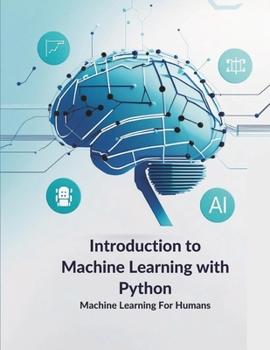Introduction to Machine Learning with Python: Learn Python tools and libraries like NumPy, Pandas, Matplotlib, and Scikit-learn while exploring superv
Introduction to Machine Learning with Python: A Practical Guide for Beginners is the ultimate resource for anyone who wants to understand the core concepts of artificial intelligence and apply them using Python. Designed for beginners and self-learners, this book provides a step-by-step journey through the world of machine learning, combining theoretical foundations with hands-on coding practice.
From the first chapter, readers are introduced to the fundamentals of machine learning, its different types, and how Python has become the most powerful tool for AI development. You will learn how to set up your machine learning environment, explore the Python ecosystem, and understand ethical considerations when working with AI systems.
The book moves into Python basics for machine learning, covering essential programming skills, control structures, and the most important libraries for data science and AI, including NumPy, Pandas, Matplotlib, and Scikit-learn. These tools form the backbone of modern machine learning, enabling you to handle data, create visualizations, and implement algorithms with ease.
Data is the heart of every AI system, and this book dedicates a section to data preprocessing and exploration. Readers will discover how to clean and prepare data, manage missing values, detect outliers, and perform exploratory data analysis (EDA). With the help of visualizations powered by Matplotlib and Python's data-handling techniques, you will learn how to shape raw datasets into high-quality inputs for machine learning models.
Next, the book dives into supervised learning. Starting with linear regression and decision trees, you will progress to advanced algorithms such as Support Vector Machines and kernel functions. Each concept is explained in simple terms, followed by practical machine learning projects to reinforce your understanding. By the end of this section, you will be confident in applying supervised learning techniques to real-world problems.
The journey continues with unsupervised learning, where you will explore clustering algorithms, dimensionality reduction, and anomaly detection. These techniques allow you to uncover hidden patterns, reduce complexity, and identify unusual behaviors in datasets. With hands-on applications, you will see how unsupervised learning can be used in industries ranging from healthcare and finance to marketing and cybersecurity.
Unlike many overly technical books, this guide balances theory and practice. Each topic is supported by clear explanations, coding exercises, and applied examples. Whether you are a student, researcher, or professional, this book will give you the foundation to understand how AI systems work and the confidence to build your own models.
By the time you finish, you will have mastered:
The fundamentals of machine learning with Python.
Essential Python tools and libraries: NumPy, Pandas, Matplotlib, Scikit-learn.
Data preprocessing, including handling missing data and detecting outliers.
Supervised learning algorithms: Linear Regression, Decision Trees, Support Vector Machines.
Unsupervised learning methods: Clustering, Dimensionality Reduction, Anomaly Detection.
Real-world applications through applied machine learning techniques and projects.
Whether your goal is to enter data science, enhance your career with AI skills, or simply gain a deeper understanding of machine learning, this book provides the roadmap you need. It bridges the gap between theory and application, making Introduction to Machine Learning with Python an essential companion for anyone ready to explore the future of artificial intelligence.





